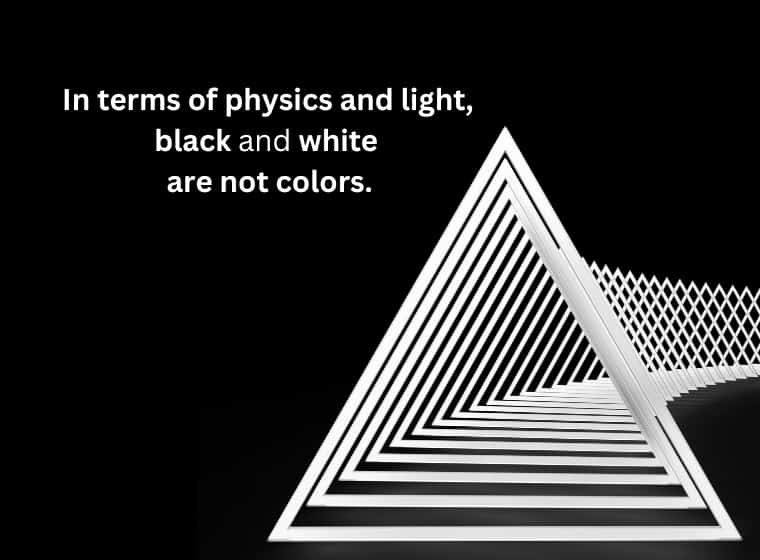Are black and white colors? We all ask ourselves this question. The quick answer is that it depends on the context. Black is a color sometimes. Yet occasionally, even white is a color.
Sometimes black is a color, while other times, it is simply the absence of light. On the other hand, white light is a mixture of all colors in the spectrum, but it can also be perceived as a lack of color.
To delve deeper, we need to discuss some concepts related to color theory, such as what color models are, where they are used, and, most importantly, what colors are. Let’s get started.

What is Color?
Color is a visual perception created by light and how it interacts with the human eye and brain. When light enters the eye, cone cells in the retina absorb it.
These cones, or photoreceptor cells, are sensitive to different wavelengths of light, which correspond to various colors. The brain interprets these signals as colors, allowing us to distinguish between shades and hues.
The human eye contains three types of cone cells, each sensitive to a specific wavelength of light. These type of cone cells are referred to as:
- S cones: short-wavelength cones.
- M cones: medium-wavelength-sensitive cones.
- L cones: long-wavelength-sensitive cones.
S cones in our retina are most sensitive to blue light with a 420-440 nanometers wavelength. M cones are most sensitive to green light with a wavelength of 534-545 nanometers, while L cones are most sensitive to red light with 564-580 nanometers.
That’s why red, green, and blue are the primary colors of light. Thus, we have a trichromatic color vision. [1]
But how exactly do we perceive color? Let’s take green grass as an example.
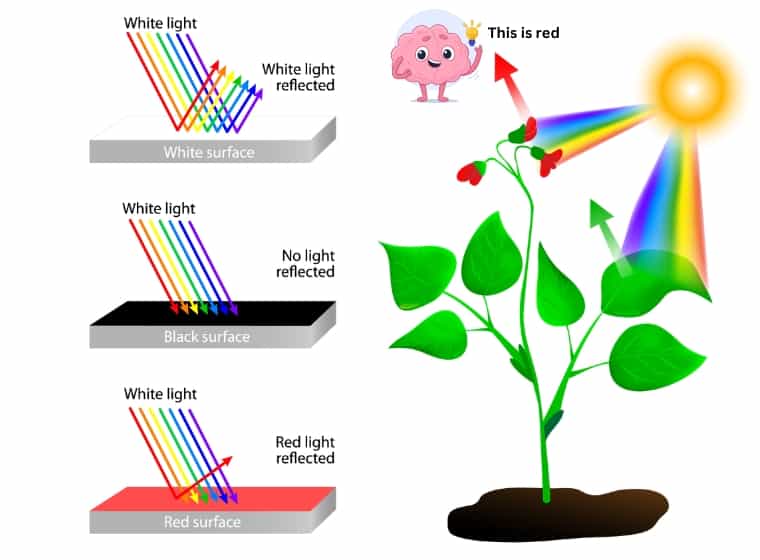
The human eye perceives the grass as green because light interacts with it. Thus grass absorbs and reflects certain wavelengths. Also, the cones in the retina help the brain perceive this reflection as color.
Green is a color with a wavelength of 495-570 nanometers. When light shines on green grass, some wavelengths are absorbed while others are reflected back to our eyes.
The pigments in the grass, such as chlorophyll, absorb all other colors of light except green, which is reflected.
So when this green light reflection interacts with the human eye, it is absorbed by cones sensitive to green wavelengths. Subsequently, these cones send signals to the brain, which are interpreted as the color green.
But when all of the light is reflected, you see all the wavelengths. This means you see white. In contrast, if there is no reflected light, you see black. This is the absence of light.
When all light is absorbed or reflected, you might see black or white. This depends on the color model used. It can be additive or subtractive. To understand better, let’s find out what they are.
Primary Colors of Light, Pigment, and Ink
There are three main color models: RGB, CMYK, and RYB. Each of these has primary colors. They are the pillars of the color models, like the foundation of a house.
RGB is a color model used in digital technology that uses light. Its primary colors are red, green, and blue. When it comes to pigments, we’re talking about the RYB and CMYK color models.
RYB is the color model used in traditional art for mixing paints and pigments. On the other hand, CMYK is used in printing and works with inks.
In contrast to the RYB model, which uses red, yellow, and blue as primaries, CMYK uses cyan, magenta, yellow. Black (K) is an addition.
So, black is a color. Right? But first, let’s look at what additive and subtractive models are.
Additive and Subtractive Color Models
Above, we mentioned three major color models or spaces: RGB, RYB, and CMYK. But there are only two pairs of color types: additive and subtractive.
CMYK is a subtractive color model, whereas RGB is an additive color model.
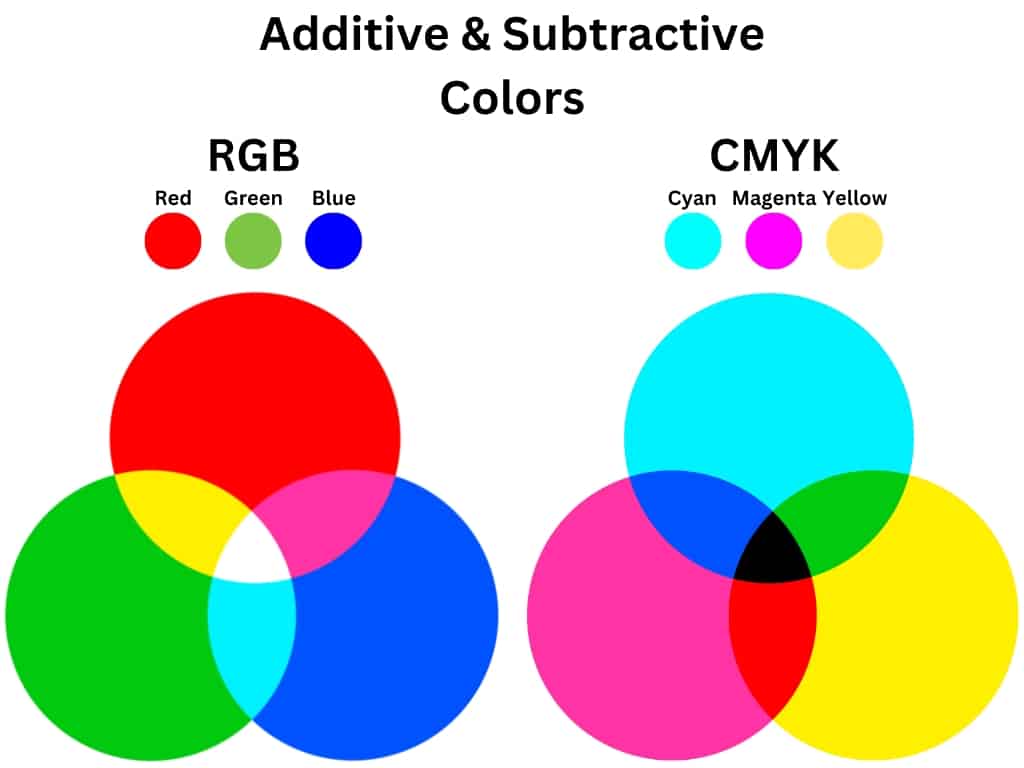
Additive
The additive color model creates colors by adding different light colors together. This is why it is referred to as RGB.
The RGB primary colors (red, green, and blue) are additive. These were chosen because the human eye contains cells in its retina called cones. These are sensitive to red (L cones), green (M cones), and blue (S cones) light.
Does what we just said about how the human eye perceives color make sense?
It is called additive because it begins with black (darkness) and adds red, green, and blue light to produce the colors of the visible spectrum.
In physics, the colors we see are created by combining the primary colors of light (red, green, and blue) in different intensities.
When the primary colors of light are combined at their highest intensity, you get white.
Furthermore, white light is composed of all the colors of the spectrum. Rainbow colors are the best example.
You may not realize it, but everything digital, whether it’s a laptop, PC, smartphone, tablet, TV, or display, uses additive colors.
Each display pixel comprises three sub-pixels: red, green, and blue. By varying the intensity of each sub-pixel, it is possible to create millions of colors.
When all three sub-pixels are at their highest intensity, the main pixel will appear white. On the other hand, when all three sub-pixels are at their lowest intensity, the main pixel will appear black.
This method is known as additive color mixing because the primary colors are added together to create other colors.
Subtractive
We all learned in school that the primary colors are red, yellow, and blue, but this is only sometimes true.
RYB is used to mix pigments and paints, while the CMYK model works with dyes and inks. Therefore, the RYB and CMYK color models have different uses.
However, the RYB model can achieve a smaller range of colors than the CMYK model.
The CMYK color space is used in printing, where cyan, magenta, yellow, and black (key) inks are combined in different amounts to create a wide range of colors. In addition, black ink is used for two reasons:
- To easily achieve black with a single ink.
- It’s cheaper to use only one ink than three to get black.
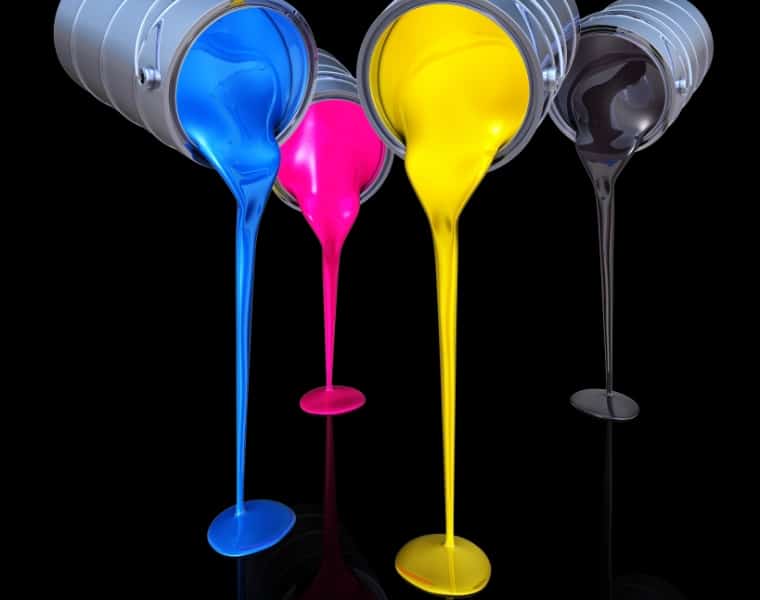
This model is used in the printing industry, producing a more precise and accurate range of colors than the RYB model.
The primary colors in the subtractive color model are cyan, magenta, and yellow. Moreover, it is associated with the CMYK color model.
Cyan, magenta, and yellow are subtractive colors because they work on the principle of subtracting specific wavelengths of light from the visible spectrum to create new colors.
These colors were chosen because they absorb certain colors of light while reflecting others. Cyan, for example, absorbs red light while reflecting blue and green light, magenta absorbs green light while reflecting red and blue light, and yellow absorbs blue light while reflecting red and green light.
The subtractive model starts with white (paper) and subtracts the additive colors (red, green, and blue) by using their complements (cyan, magenta, and yellow). As color is added, the result is darker, ending with black.
When all three are combined in an equal proportion, all light is subtracted, resulting in black.
Did you understand the difference between additive and subtractive colors?
You may have heard of them under different terms, such as additive or subtractive color mixing, but they refer to the same thing.
Additive color mixing is a kind of mixing where the primary colors of light (red, green, and blue) are added together to create other colors. In contrast, subtractive color mixing creates colors by subtracting different wavelengths of light from white paper.
Furthermore, additive mixing starts with black and adds colors of light together, while subtractive mixing begins with white and subtracts certain wavelengths to create other colors.
Is White a Color? Is Black a Color?
Is black a color? Or is it the absence of light?
Black and white are often considered colors, but it depends on context.
Black and white are not in the color spectrum because the color spectrum refers to the range of colors that can be created by visible light.
Furthermore, they are not part of this spectrum because they are not created by a specific wavelength of light.
In terms of physics and light, black and white are not considered colors. This is because black is the absence of all visible light, and white is the presence of all visible light combined.
Therefore, in this context, black and white are not colors but rather light properties.
In addition, white light is considered a combination of all spectrum colors, while black is the absence of light. So that’s why you see black or darkness when light is absent. Or when all colors of light are combined, you see white.
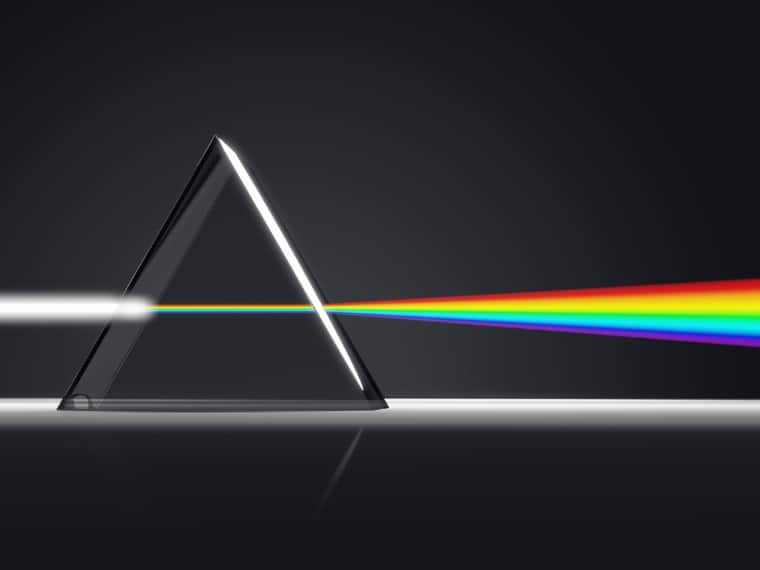
As a result, black is not a color in the additive color model. It’s the lack of light. Therefore, white is not a color. It is the existence of all light colors.
When it comes to pigments and paints, black is a color. According to subtractive color mixing, black results from an equal mixture of the primary subtractive colors (cyan, magenta, and yellow).
Thus, this mixture absorbs all colors of light and creates black.
On the other hand, white isn’t considered a color in the subtractive color model because it is the absence of color.
Achromatic Colors
According to color theory, black and white are considered achromatic colors.
Achromatic colors have lightness but lack hue and include all shades of black, white, and gray. These colors are created by the absence or suppression of color. In contrast, chromatic colors have characterizing hues, saturation, and lightness; They can be created by specific wavelengths of light.
A chromatic scheme includes all colors that have characterizing hues, such as red, yellow, and blue, as well as lightness, and saturation. Moreover, they have specific wavelengths of light.
An achromatic color scheme includes any shade of white, black and their mixing results (gray shades). Thus, they lack in hue and saturation.
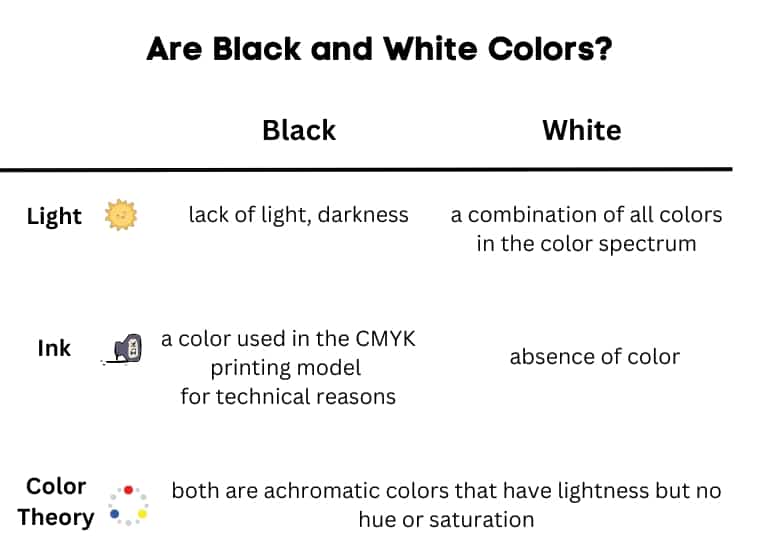
How to Make Black and White
Creating black and white depends on the type of colors used.
If you work with subtractive colors (CMY), black can be obtained by mixing equal proportions of the primary colors: cyan, magenta, and yellow.
To make black paint, you can use Phthalo blue, Quinacridone magenta, and Hansa yellow. As an alternative, you can mix Phtalo Blue with Burnt Umber.
White, on the other hand, does not need to be created. In the subtractive model, white is the absence of color. Basically, it’s like a piece of paper.
In the additive model (RGB), white can be created by overlapping the three primary colors (red, green, and blue) at maximum intensity. In this model, black is the absence of light (darkness).
Last Words on Black and White as Colors
“Are black and white colors?” is one of the most disputed questions related to color. If you ask a scientist, you’ll discover that black is not a color, but white is a color. On the other hand, artists would provide a different answer, such as “Black is a color; white is not.”
In the world of light, white is a color made by overlapping the primary colors of light (red, green, and blue) at equal intensities, while black is the absence of light.
When it comes to dyes and inks, white is the absence of color, while black is a color created by mixing the primary subtractive colors (cyan, magenta, and yellow).
On the other hand, according to color theory, white and black are considered achromatic colors that lack hue.
Technically, some designers consider black and white to be color-enhancing shades rather than colors.
Interestingly, pure white or pure black are uncommon in nature. Unfiltered sunlight and black holes are the only completely white or black things.
Back to the original question, “Are black and white colors?” we hope this article has helped to clarify. Please share it with your friend to help us spread the word.

